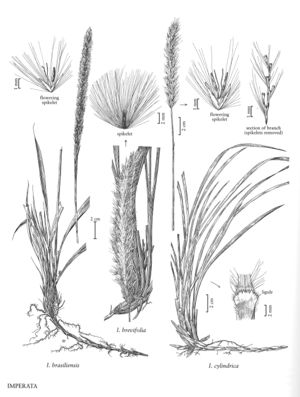Imperata brevifolia
Culms 51-129 cm. Ligules 0.7-2.9 mm; blades 7-14 mm wide, linear to lanceolate, abaxial surfaces smooth, adaxial surfaces sometimes densely pilose basally, otherwise scabrous. Panicles 16-34 cm, dense; lower branches 2-5 cm, divergent. Callus hairs 8-12 mm; glumes 2.7-4.1 mm; lower lemmas 2.5-3.9 mm, membranous, glumelike; upper lemmas 1.4-2.4 mm, completely surrounding the ovary; stamens 1, filaments dilated at the base; anthers 1.3-2.3 mm, yellow to orange; styles 0.9-2.4 mm; stigmas 2.1-4 mm, purple to brown. 2n = 20.
Distribution
N.Mex., Tex., Utah, Calif., Ariz., Nev.
Discussion
Once known from wet or moist sites in the southwestern deserts from southern California, Nevada, and Utah to western Texas, Imperata brevifolia is currently known only from populations in Grand Canyon National Park. It was last collected outside the park in the early 1970s at a site that is now under Lake Powell. Most collections were made before 1945, in sites that are now used for housing or agriculture.
Imperata brevifolia was listed as a noxious weed by the state of California. The reason for the listing is not clear; it may have stemmed from confusion of this native species with one of the introduced weedy species.
In September 2003, G.F. Hrusa succeeded in persuading the California authorities that Imperata brevifolia should be taken off the state's noxious weed list. Endangered species status is now being sought.
Selected References
None.
Lower Taxa
"decumbent" is not a number.
